Ambulatory hairdryer
a hairdryer and ambulatory technology, applied in the field of ambulatory hairdryers, can solve the problems of not being practical, hose interference with many activities, and non-productive time, and achieve the effects of small and practical batteries, high heat capacity polymers, and convenient us
- Summary
- Abstract
- Description
- Claims
- Application Information
AI Technical Summary
Benefits of technology
Problems solved by technology
Method used
Image
Examples
Embodiment Construction
[0026]While this invention may be embodied in many different forms, there are described in detail herein specific preferred embodiments of the invention. This description is an exemplification of the principles of the invention and is not intended to limit the invention to the particular embodiments illustrated.
[0027]For the purposes of this disclosure, like reference numerals in the figures shall refer to like features unless otherwise indicated.
[0028]FIG. 1 shows the helmet 10 in use on the head of the user. Brow strap 8 holds it on the head. Microphone boom 9 allows for the user to answer telephone calls during the drying operation. On switch 11 and off switch 12 are used to turn the device on and off. Fan speed switches 13 and 14 are used to accelerate and decelerate the fan respectively. Temperature increase switch 15 and decrease switch 16 are used to adjust the temperature in the helmet.
[0029]Fan 17 is used to force air in from the outside and direct it down through channel 1...
PUM
 Login to view more
Login to view more Abstract
Description
Claims
Application Information
 Login to view more
Login to view more - R&D Engineer
- R&D Manager
- IP Professional
- Industry Leading Data Capabilities
- Powerful AI technology
- Patent DNA Extraction
Browse by: Latest US Patents, China's latest patents, Technical Efficacy Thesaurus, Application Domain, Technology Topic.
© 2024 PatSnap. All rights reserved.Legal|Privacy policy|Modern Slavery Act Transparency Statement|Sitemap



